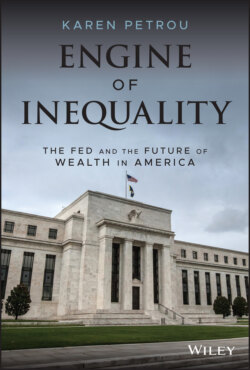Читать книгу Engine of Inequality - Karen Petrou - Страница 11
What We Know about Inequality that Economists Don't
ОглавлениеDecades before today's economists reached their conclusions based on complex models that only more or less have anything to do with real life, Harry S. Truman observed, “An economist is a man who wears a watch chain with a Phi Beta Kappa key at one end and no watch at the other.”12 The Federal Reserve and the economists on which it relies have been clutching fancy chains, but most Americans know what economic time it is and many are not the least bit happy about it.
Americans once proudly thought – and many economists still believe – that the US is a middle-class nation. However, the middle class has been hollowed out. Now the US consists of a large majority of folks barely getting by plus a tiny sliver of wealthy households.13 In fact, just three Americans – Bill Gates, Jeff Bezos, and Warren Buffett – own more of the nation's financial wealth than the bottom half of the country combined.14 Even what's left of the middle class isn't what it was – 23 percent of families that are still considered middle class skipped medical treatments they could no longer afford even before the COVID crisis left many more Americans without employer-provided health insurance.15 Despite sharp spikes in the cost of medical and child care, education, and housing, middle-class median income in inflation-adjusted terms was about the same in 2019 as 2001.16
In fact, income inequality in 2019 was even worse in the US than it was during the Great Depression.17 Reflecting this, 37 percent of the US was at grave financial risk after only a $400 unexpected expense.18 Clearly, unexpected expenses poured down in waves after COVID hit, increasing the percentage of Americans who couldn't pay their monthly bills in full by 12.5 percent between just late 2019 and April 2020.19
The younger you are, the worse it gets. In the “theft of a decade” characterizing the years after 2008 for younger citizens, Americans entering the workforce were mired in student debt, struggled to find jobs, and generally owned nothing more than a car that they could call their own.20 In 2019, the average net worth of millennials was still just $8,000, far less than earlier generations at their age.21 When COVID hit millennials yet again, some called them the “unluckiest generation ever.”22 This might not be historically true, but anger across the entire US political spectrum tells us that it's how millions feel. Even relatively wealthy Americans said that their financial position was a cause of acute stress, and that was before COVID.23
Cut these data down to see how African Americans and Hispanics are doing and one sees still sharper divides – racial economic-equality disparities are as bad as they were before the civil rights era promised Black Americans a better, fairer deal. There is now a bigger homeownership gap between Black and white Americans than before 1968, when critical fair-housing legislation was first signed into law.24 In 2016, white household average wealth was seven times that of Black households and five times that of Hispanics.25
